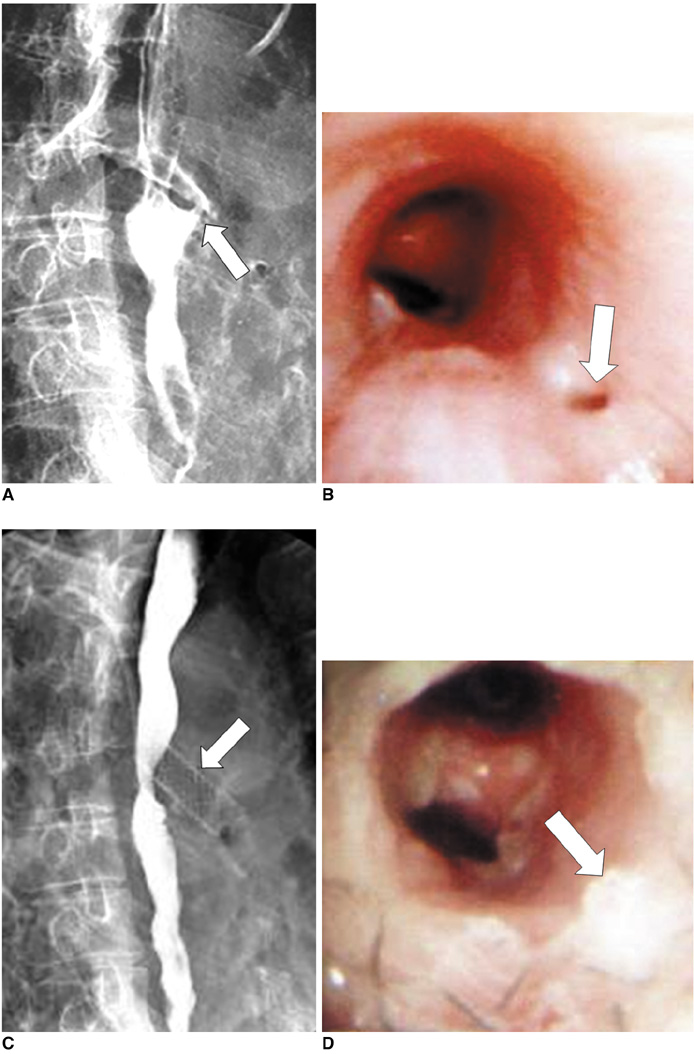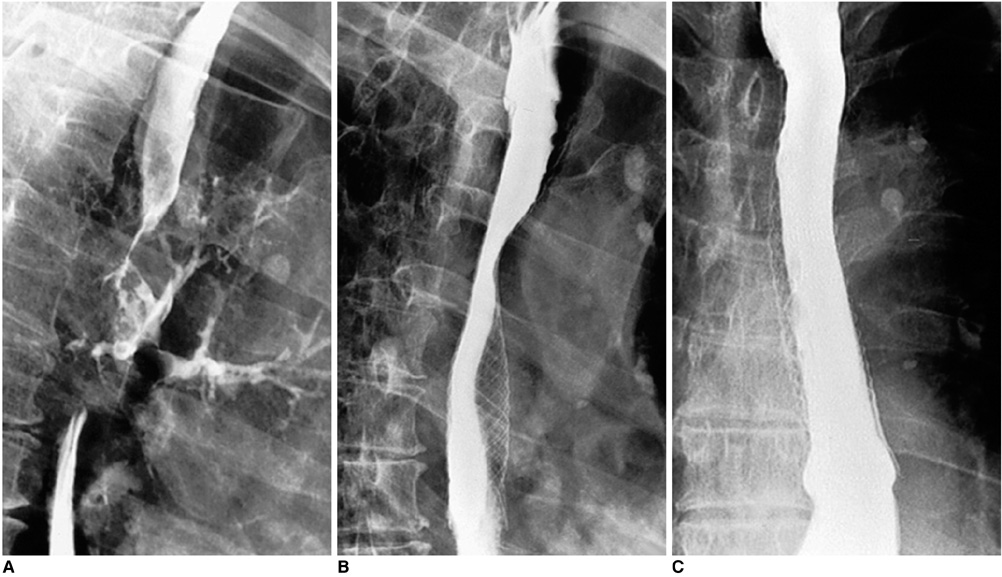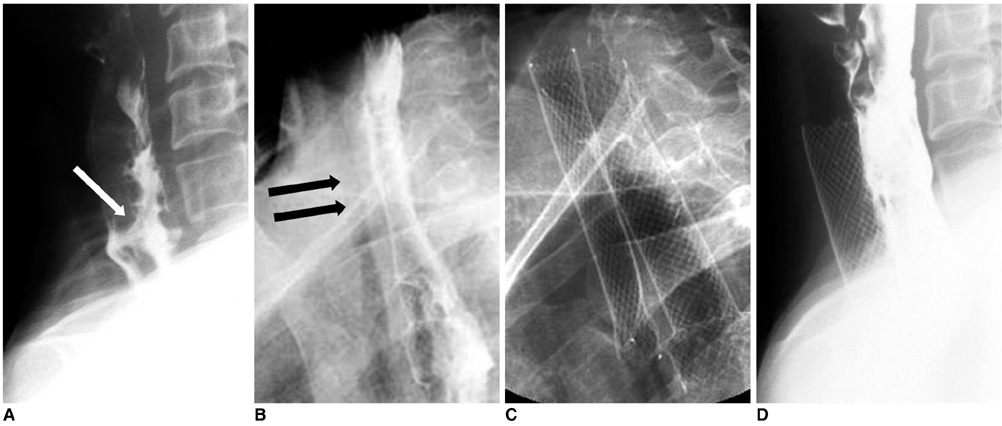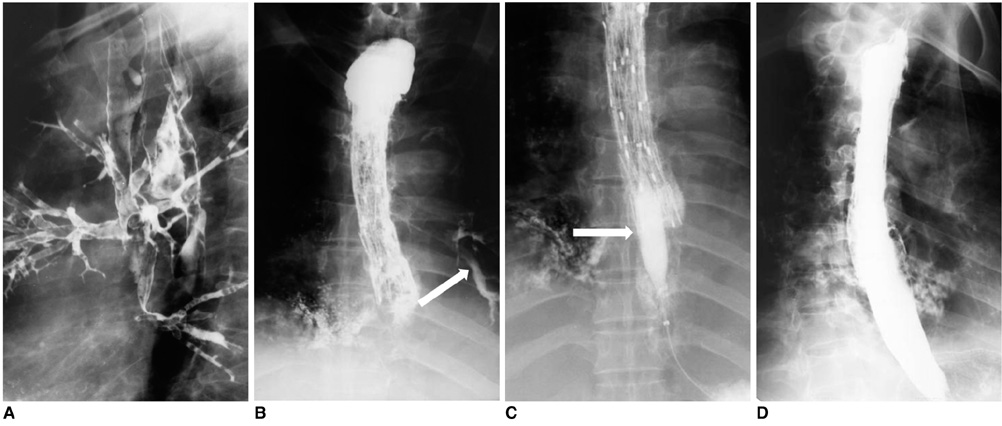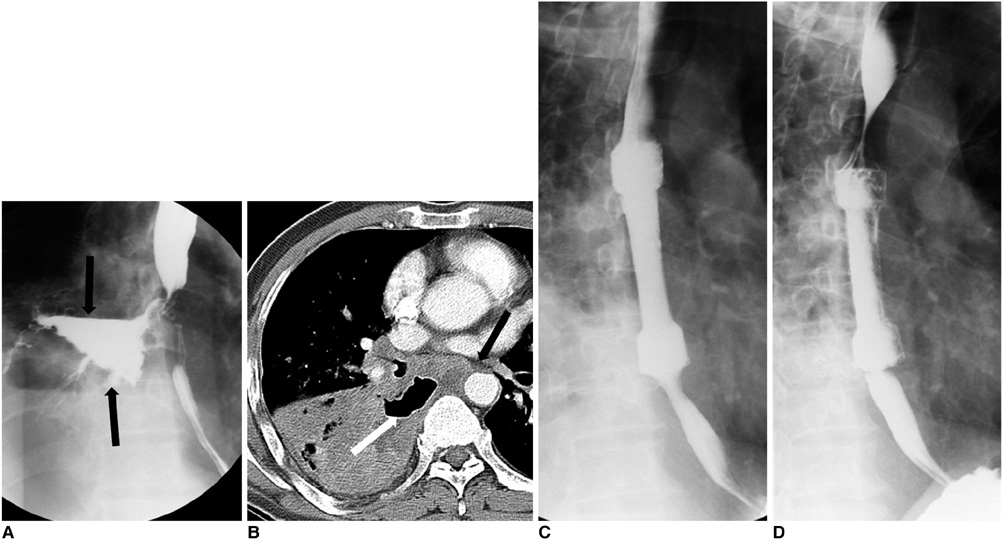Korean J Radiol.
2010 Apr;11(2):133-140. 10.3348/kjr.2010.11.2.133.
Interventional Management of Esophagorespiratory Fistula
- Affiliations
-
- 1Department of Radiology and Research Institute of Radiology, University of Ulsan College of Medicine, Asan Medical Center, Seoul 138-736, Korea. hysong@amc.seoul.kr
- KMID: 1783188
- DOI: http://doi.org/10.3348/kjr.2010.11.2.133
Abstract
- An esophagorespiratory fistula (ERF) is an often fatal consequence of esophageal or bronchogenic carcinomas. The preferred treatment is placement of esophageal and/or airway stents. Stent placement must be performed as quickly as possible since patients with ERFs are at a high risk for aspiration pneumonia. In this review, choice of stents and stenting area, fistula reopening and its management, and the long-term outcome in the interventional management of malignant ERFs are considered. Lastly, a review of esophagopulmonary fistulas will also be provided.
MeSH Terms
Figure
Reference
-
1. Shin JH, Song HY, Ko GY, Lim JO, Yoon HK, Sung KB. Esophagorespiratory fistula: long-term results of palliative treatment with covered expandable metallic stents in 61 patients. Radiology. 2004. 232:252–259.2. Martini N, Goodner JT, D'Angio GJ, Beattie EJ Jr. Tracheoesophageal fistula due to cancer. J Thorac Cardiovasc Surg. 1970. 59:319–324.3. Balazs A, Galambos Z, Kupcsulik PK. Characteristics of esophagorespiratory fistulas resulting from esophageal cancers: a single-center study on 243 cases in a 20-year period. World J Surg. 2009. 33:994–1001.4. Murthy S, Gonzalez-Stawinski GV, Rozas MS, Gildea TR, Dumot JA. Palliation of malignant aerodigestive fistulae with self-expanding metallic stents. Dis Esophagus. 2007. 20:386–389.5. Weigert N, Neuhaus H, Rosch T, Hoffmann W, Dittler HJ, Classen M. Treatment of esophagorespiratory fistulas with silicone-coated self-expanding metal stents. Gastrointest Endosc. 1995. 41:490–496.6. Abadal JM, Echenagusia A, Simo G, Camunez F. Treatment of malignant esophagorespiratory fistulas with covered stents. Abdom Imaging. 2001. 26:565–569.7. Tomaselli F, Maier A, Sankin O, Woltsche M, Pinter H, Smolle-Juttner FM. Successful endoscopical sealing of malignant esophageotracheal fistulae by using a covered self-expandable stenting system. Eur J Cardiothorac Surg. 2001. 20:734–738.8. Han YM, Song HY, Lee JM, Cho SI, Chung GH, Kim CS, et al. Esophagorespiratory fistulae due to esophageal carcinoma: palliation with a covered Gianturco stent. Radiology. 1996. 199:65–70.9. Saxon RR, Barton RE, Katon RM, Petersen BD, Lakin PC, Timmermans H, et al. Treatment of malignant esophageal obstructions with covered metallic Z stents: long-term results in 52 patients. J Vasc Interv Radiol. 1995. 6:747–754.10. Kishi K, Nakao T, Goto H, Kimura M, Sonomura T, Yamanaka N, et al. A fast placement technique for covered tracheobronchial stents in patients with complicated esophagorespiratory fistulas. Cardiovasc Intervent Radiol. 2005. 28:485–489.11. van den Bongard HJ, Boot H, Baas P, Taal BG. The role of parallel stent insertion in patients with esophagorespiratory fistulas. Gastrointest Endosc. 2002. 55:110–115.12. Balazs A, Kupcsulik PK, Galambos Z. Esophagorespiratory fistulas of tumorous origin. Non-operative management of 264 cases in a 20-year period. Eur J Cardiothorac Surg. 2008. 34:1103–1107.13. Seto Y, Yamada K, Fukuda T, Hosoi N, Takebayashi R, Chin K, et al. Esophageal bypass using a gastric tube and a cardiostomy for malignant esophagorespiratory fistula. Am J Surg. 2007. 193:792–793.14. Wang MQ, Sze DY, Wang ZP, Wang ZQ, Gao YA, Dake MD. Delayed complications after esophageal stent placement for treatment of malignant esophageal obstructions and esophagorespiratory fistulas. J Vasc Interv Radiol. 2001. 12:465–474.15. Deviere J, Quarre JP, Love J, Cremer M. Self-expandable stent and injection of tissue adhesive for malignant bronchoesophageal fistula. Gastrointest Endosc. 1994. 40:508–510.16. Saxon RR, Barton RE, Katon RM, Lakin PC, Timmermans HA, Uchida BT, et al. Treatment of malignant esophagorespiratory fistulas with silicone-covered metallic Z stents. J Vasc Interv Radiol. 1995. 6:237–242.17. Nam DH, Shin JH, Song HY, Jung GS, Han YM. Malignant esophageal-tracheobronchial strictures: parallel placement of covered retrievable expandable nitinol stents. Acta Radiol. 2006. 47:3–9.18. Binkert CA, Petersen BD. Two fatal complications after parallel tracheal-esophageal stenting. Cardiovasc Intervent Radiol. 2002. 25:144–147.19. Hu Y, Zhao YF, Chen LQ, Zhu ZJ, Liu LX, Wang Y, et al. Comparative study of different treatments for malignant tracheoesophageal/bronchoesophageal fistulae. Dis Esophagus. 2009. 22:526–531.20. Duranceau A, Jamieson GG. Malignant tracheoesophageal fistula. Ann Thorac Surg. 1984. 37:346–354.21. Angorn IB. Intubation in the treatment of carcinoma of the esophagus. World J Surg. 1981. 5:535–541.22. Kim KR, Shin JH, Song HY, Ko GY, Kim JH, Yoon HK, et al. Palliative treatment of malignant esophagopulmonary fistulas with covered expandable metallic stents. AJR Am J Roentgenol. 2009. 193:W278–W282.
- Full Text Links
- Actions
-
Cited
- CITED
-
- Close
- Share
- Similar articles
-
- A Case of Tuberculous Esophagorespiratory Fistula Managed by Silicone - Covered Self - Expendable Metal Stent
- Treatment of Esophagorespiratory Fistulas with Silicone-Coated Self-Expanding Metal Stents
- Treatment of Esophagorespiratory Fistulas Associated with Esophageal Carcinoma: Effectiveness and Problems of a Modified Gianturco Stent
- Interventional Management of Gastrointestinal Fistulas
- Silicone - Covered Self - Expandable Metal Stents for the Palliation of Malignant Esophageal Obstruction and Esophagorespiratory Fistulas

